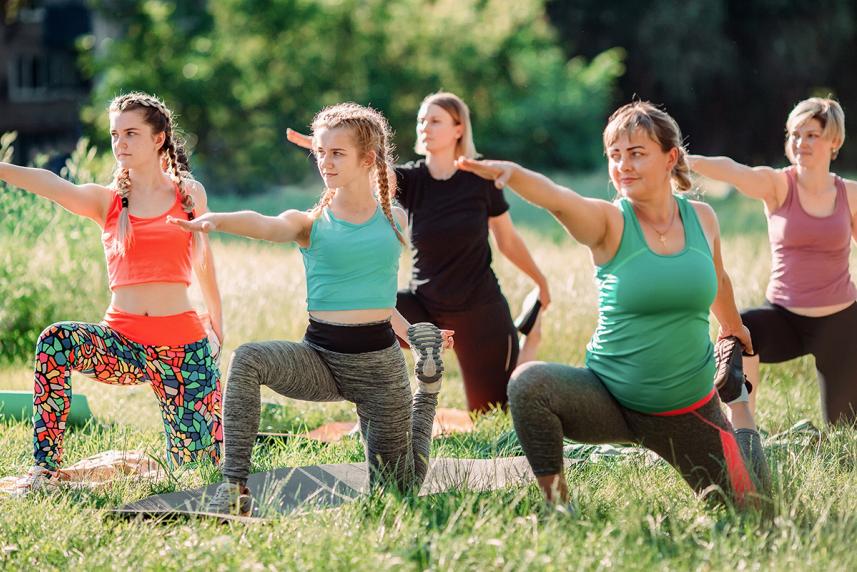
We have more than 90,000 doctors at over 2,000 locations. Our team will help you get the care you need, when and where you need it.

Boost your health and confidence with these easy-to-follow tips to shake up your workout routine.
The long and lovely days of summer are inviting you to spend more time outside. We’re inviting you to use that energy to level up your fitness routine.
Whether you’re new to fitness or a gym lover, it’s important to change things up. When you do the same workout all the time, your body and muscles get used to the routine. And that means you’ll make less progress as time goes on.
But when you keep your mind and body guessing, the benefits of exercise can keep increasing, says Ben Brock. He’s a certified strength and conditioning specialist and the director of community programs at OptumCare® Arizona. Brock says that when you move more, it can have positive effects on the rest of your body and even your life.
“Movement improves the other aspects of your life, too,” says Brock. These include your relationships, stress level, eating habits, sleep quality and mental health. (Read more about movement and your mind). All because you are committed to moving your body more.
Plus, changing things up beats boredom and keeps you excited to keep coming back for more.
Sounds pretty good, right? To kick-start (or reenergize) your love of movement, we’ve created a two-week fitness challenge to help you feel better and fitter in no time.
One note: Before starting an exercise routine, it’s important to talk to your health care team. If you need a doctor (or want to find a new one who gets you), we can help. Find Optum providers near you now.
Anyone can try this fitness challenge. And you don’t even need any fancy equipment or a gym membership.
The challenge: Commit to leveling up your fitness routine for the next two weeks. For newbies, that could mean walking for just 10 minutes a day, three days a week. If you already do a lot of exercising, like walking or biking, maybe your goal will be to add some strength training to your routine.
Follow these steps to create your program.
Self-awareness is the first step toward making positive change. So be honest with yourself about the amount of time you spend moving each day.
Some people find that estimates are enough to measure. Others may want to track their movement with a fitness tracker or with good old-fashioned pen and paper. Log your activity for several days to see where you stand. Then use your log to track your progress once you start the challenge.

We have more than 90,000 doctors at over 2,000 locations. Our team will help you get the care you need, when and where you need it.
At the end of the two weeks, what do you want to have accomplished? Use your current exercise routine as a starting point to see what you could add or change up. Maybe you’ll even decide to try another activity altogether.
Remember, you form habits by doing the same things over and over. Make sure to aim for goals that are reasonable and ones you’re likely to keep doing after this challenge is over.
There are a lot of ways to exercise. And experts agree that the best way is to find something you’ll enjoy doing. “Anything that makes you happy,” says Bethany Gray, DO. She’s the medical director at Optum in Irvine, California. (Get inspired to work out in the water.)
If you don’t love lifting weights but want to do strength work, a Pilates or a group fitness class could be a good fit. Or if you want to do cardio but hate running, you could try biking, swimming or walking instead.
Need some inspiration for how to upgrade your routine? Here are some ideas to help you shake things up:
Work it at work. If you’re at an office 40 hours a week, Dr. Gray says you can start by combining work and working out. Do a few jumping jacks or squats at your desk for some heart-pumping breaks throughout the workday.
Move more during the day. If you exercise regularly (about three times a week or more), think about how much you move when you’re not biking, walking or in a fitness class. You may spend most of the day in a chair at your desk. Where can you sneak in extra fitness challenges? Maybe it’s balancing on one foot while you brush your teeth or walking around your office every hour.
Try other forms of movement. Are you always running but haven’t seen the inside of a weight room in a decade? Or are you lifting weights but never working on your flexibility? Mix up your routine by trying a new form of exercise during this challenge. The best fitness plans feature all the major categories of movement, says Brock. These include heart-healthy exercises (like running), strength training, plus stretching and balance exercises. So every week, he says, aim for 150 minutes of cardio, two or three strength sessions, and regular stretching and balance exercises.
Make the time to move. Not having enough time is one of the biggest reasons that many people don’t work out. But it doesn’t take hours every day to get fit. You just need to make every minute count. If you’re already at a medium-intensity level, research shows that high-intensity interval training (HIIT) can be a time-saving way to work out, says Dr. Gray. HIIT is a style of workout that involves periods of intense exercise followed by brief periods of rest.
Dr. Gray says she’s a big fan of HIIT because she can fit in a great workout in as little as 20 minutes. “Get your heart rate up, give yourself some time to recover. And it’s been proven to be one of the most time-effective, muscle-building, cardiovascular-beneficial exercises,” she says.
Add a rest day. Moving every day is key for good health. But doing intense exercise each and every day can hinder your recovery and performance. As a reminder, Brock points out that the body actually gets stronger during the recovery cycle. “You don’t get stronger in the weight room, you get stronger the next day. You get stronger as your muscles are repairing,” he says. For you, maybe that’s adding a true day off to your week. Or maybe it’s adding in some active recovery time, such as a yoga class or gentle walk.
Change your workout scenery. Adding something new to a workout can be a big mental health boost. For some, that’s calling a friend during a walk or listening to your favorite podcast as you cycle indoors. But there are specific benefits that come from spending time outdoors.
“Being outside in nature, getting a little bit of sun, hearing the birds or whatever in nature makes you happy, that’s all good for your mental health as well,” says Dr. Gray.
Enlist a buddy. Have you been meaning to start a neighborhood walking group? Well, now’s your chance. When people have someone holding them accountable, they’re more likely to stick with their goals, says Brock. Find a friend to join you for a walk or an exercise class. Or ask a friend if you can text them every time you walk a mile.
When you set a goal, it’s important for it to be specific. For example, “I will walk around my block three times a week for 20 minutes for the next two weeks.” This is a much stronger goal than, say, “I will move more each day.” When you have a set plan in place, it’s easier to exercise regularly and know whether you’ve met your goal.
And be sure that your goal is realistic. Doing one change at a time and committing to it is better than throwing a bunch of activities at the wall and seeing what sticks. After all, your goal is to stay with this plan over the long term.
That said, you want to make sure that you’re challenged at least a little bit. “A lot of studies have shown that if people can get a minimum of 20 minutes of moderate-intensity exercise three days a week or more, that’s really where the health benefits come in,” says Dr. Gray. Moderate-intensity exercise could be anything from taking a brisk walk to gardening or ballroom dancing.1
But if that sounds overwhelming, know that any movement is better than none, says Brock. Maybe that means making an extra loop at the grocery store or just walking around your neighborhood with a friend. Any and every minute of exercise gets you closer to the recommended amount and all the health benefits that come with it. As Dr. Gray says, “Whatever it may be, just get yourself up and moving.”
Finished all three steps? All that’s left now is to get started. After your two weeks are up, think about your progress. See what worked and what didn’t and keep on moving from there. You’ll be feeling fitter before you know it.
Need extra support for creating and sticking with your goals? Work one-on-one with a virtual coach from AbleTo. Learn more.
Source
© 2024 Optum, Inc. All rights reserved. Do not reproduce, transmit or modify any information or content on this website in any form or by any means without the express written permission of Optum.
The information featured in this site is general in nature. The site provides health information designed to complement your personal health management. It does not provide medical advice or health services and is not meant to replace professional advice or imply coverage of specific clinical services or products. The inclusion of links to other websites does not imply any endorsement of the material on such websites.
Consult your doctor prior to beginning an exercise program or making changes to your lifestyle or health care routine.
Stock photo. Posed by models.